 | E-mail to Birds Korea |
 | KWBS |
in the Region
 | The Oriental Bird Club |
 | BirdLife International (Asia) |
Eocheong Island, April 30
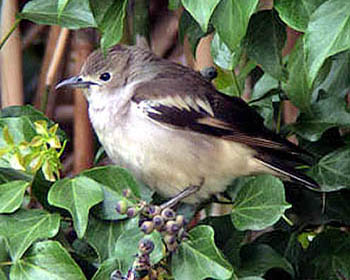

The sky cleared overnight, with the wind swinging to the northwest. Although numbers of birds were reasonably high in the village, with 150-200 Little Bunting the commonest grounded migrant, much of the rest of the island seemed relatively empty, with best birds at the lighthouse being another male Red-throated Flycatcher and a Wryneck. The regular highlights included 5-7 Chinese Pond Heron, 1 Greater Short-toed Lark and the Ferruginous Flycatcher still, while the run of interesting starlings continued: the patience and determination of Kawaguchi san confirmed that the 6 starlings now present on the island are indeed made up of no less than 4 species: 2 Grey, 2 Chestnut-eared (one new male and the female still), the male White-shouldered Starling still, and a female Daurian Starling (presumably present and extremely elusive for 3 days)!
Although considered a very rare migrant in South Korea in recent years, the Daurian Starling was eclipsed by the discovery of a presumed Red-breasted Flycatcher Ficedula parva in the afternoon. Identification of this very worn individual was based on call (much softer than typical Red-throated/Taiga); the brownish colour of the longest upppertail coverts(matching the tail); the puce-tones to the bill (palest at the base); the warmth of the throat and face; the paleness of the underparts; the buffy tones to the eye-ring; and the "cute" facial expression (very similar to a Brown Flycatcher feeding in the same small paddock). Additional features included the apparently more pointed bill and weaker legs and feet than (most) Red-throated, and the buffy tones to the remaining edges and tips of the tertials. Although recorded on several occasions in neighboring Japan (especially in winter apparently ), this taxon has presumably not been recorded in South Korea. As always we very much welcome informed comments on the images...
Eocheong Island, April 29
Heavy rain, dense fog and strengthening winds (up to Beaufort Force 6 by evening) limited time spent in the field. Although birds were arriving through the day, it was clear that numbers were not nearly as high as those seen during a storm on almost the same date in 2002, with only thrushes numerous (100s present, including several Grey and Brown/Brown-headed Thrushes) and ca 100 Olive-backed Pipit and 75 Little Bunting grounded. Few birds of especial note were found, although there were 2 Chestnut-cheeked Starling, 5 Chinese Pond Heron and 1 Greater Short-toed Lark still, as well as a Wryneck (the spring's fourth or fifth) near the lighthouse. Best birds of the day were therefore the first Raddes' Warbler of the spring, a Blyth's Pipit, and in the evening a Grey-headed Lapwing - a surprisingly scarce migrant through South Korea.

Eocheong Island, April 28
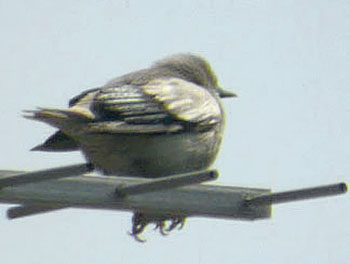
The third day in a row of sunny and fairly calm conditions saw reduced numbers and diversity, with rather fewer than the 93 species that were logged on the 27th. Good birds, however, included the Ferruginous Flycatcher (with a probable second individual being glimpsed on another part of the island in the afternoon), and 2 Greater Short-toed Lark still, and now 5 Chinese Pond Heron at the reservoir. In addition the afternoon arrivals included 3 more Japanese Yellow Bunting and the first two Mugimaki of the spring.
Outstanding highlight, however, was a male White-shouldered Starling in the company of at least 1 Chestnut-cheeked Starling: this is about the fifth record (involving perhaps seven individuals, including three together on Gageo in October 2002).
Geum Estuary, April 26 - 27
A weekend on the Geum and Mangyeong estuaries proved fruitful, with a total of 30 shorebird species. Highlights included Spoon-billed Sandpiper (2 at the Okku salt pans); Curlew Sandpiper (3 on the Geum, 1 on the Mangyeong); Ruff (one female on the Geum); Black-winged Stilt (one on the Geum); Broad-billed Sandpiper (2 on the Geum; 6 on the Mangyeong); and Marsh Sandpiper (1 on the Geum).
Among 600 or so Black-tailed Godwits along the Geum River was one individual with a yellow flag above its right knee (the flag colours for north-west Australia - see our Flag Protocols page for more details).
Besides shorebirds, a Common Buzzard was seen perched beside a ricefield near Daechon: this would seem to be a late record. The Geum River held a first-year Relict Gull; while there were 6 Siberian Blue Robins along the Mangyeong River Sea Wall.
UPDATE: Clive Minton of the AWSG has commented on Tim's flag sighting as follows:"It is fascinating that this Black-tailed Godwit turned up there on April 26th. Black-tailed Godwits did not start leaving Broome, Northwest Australia until April 12th, and virtually the whole population moved out over the next five days. This suggests that they probably flew direct to Korea (7000km) or at most only had a very short stop over somewhere."
The importance of this observation, of course, is that the tidal-flats of the Geum River are threatened by reclamation: for more on regional reclamation, go to Saemangeum Reclamation project.
Eocheong Island, April 27
More settled anticyclonic weather, with light southwesterlies and increasing visibility led to increased visible passage, with for example ca 10 Japanese Sparrowhawk north in one sample hour. Numbers of grounded migrants, with the exception of the thrushes, still remaining lower than last year, though a good arrival started to take place towards evening, with for example ca 10 Yellow-rumped Flycatcher around the village.
Other migrants in improved numbers included Pale-legged Leaf Warbler (ca 20) and Blue-and-White Flycatcher (ca 10), while new species for the spring included Indian Cuckoo (1), Chinese Grosbeak (ca 4), Yellow-breasted Bunting (1), Chestnut-cheeked Starling (1), and Black-naped Oriole (ca 10+). Highlights included another Chinese Blackbird, 2 Greater Short-toed Lark and 3 Chinese Pond Heron still, the Ferruginous Flycatcher and Pied Wheatear still, and the spring's second full adult male Red-throated or Taiga Flycatcher (sharing a small patch with the Ferruginous, a Yellow-rumped, a Blue-and-White and an Asian Brown Flycatcher...).


Eocheong Island, April 26
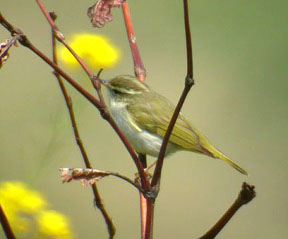

Sunny and bright conditions(though still misty with visibility ranging from 2 km to 20 km during the day) stimulated some migration, with the first decent arrival of phylloscopus warblers (ca 60 Yellow-browed including 1 or 2 "Hume's Leaf types", 10+ Dusky, 8+ Pallas's Leaf and ca 20 Eastern Crowned), a second small wave of Asian Stubtail (ca 15 logged) and Red-flanked Bluetail (ca 30), and a very few Blue-and-White (4+) and Yellow-rumped Flycatchers(4).
New species for the spring on Eocheong included Grey Nightjar (Choi S-H), Broad-billed Roller and Chinese Sparrowhawk, while the long-staying Pied Wheatear and Ferruginous Flycatcher were both still present, along with 2 Chinese Pond Heron and 3 Greater Short-toed Lark in the evening.
Eocheong Island, April 25
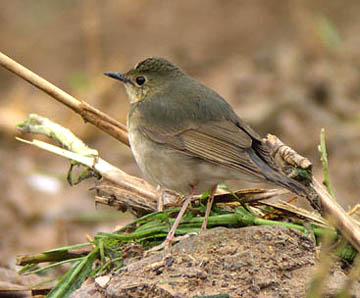
Heavy overnight rain followed by strong northerly winds prevented much movement again today, though numbers of a variety of species including Siberian Blue Robin (ca 20 seen), Grey-backed Thrush (again 50+) and Yellow-browed Bunting (10+) were rather higher than yesterday. New arrivals included the spring's first Grey-tailed Tattlers and a single Little Whimbrel (an annual migrant in very small numbers on the outer islands), while other highlights included 1 Blyth's Pipit again, and 1 Greater Short-toed Lark, the Ferruginous Flycatcher and the Pied Wheatear still.
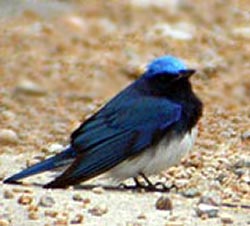
Photos © Nial Moores
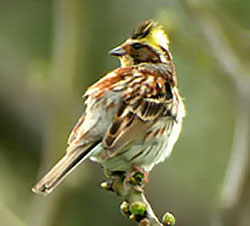
Photos © Nial Moores
Eocheong Island, April 24
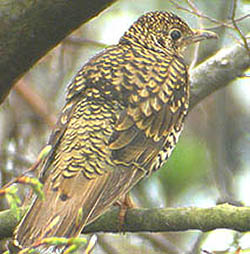
Several days of overcast conditions with frequent rain and below average temperatures seems now to be stalling migration over this part of the Yellow Sea at least, with for example only ca 5 Barn and 4 "Lesser Striated" or Red-rumped Swallows, and only single Narcissus and Blue-and-White Flycatchers all day. Although diversity remains high, few new birds today, best being the first Pechora and Blyth's Pipits of the spring and yesterday's single Wryneck still. In addition, the Ferruginous Flycatcher, Pied Wheatear and at least one Greater Short-toed Lark are still present, along with large numbers of thrushes (mostly Pale, Dusky and Grey-backed, with at least 10 White's and 4 Grey Thrushes around the village).
Eocheong Island, April 23
Heavy overnight rain, followed by showers and fog led to rather better numbers of grounded migrants, including a good range of buntings (including about 150 Black-faced, 1-2 Chestnut, 75+ Little, 5+ Tristram's and ca 8 Yellow-browed Bunting), and ca 200-300 thrushes (made up of no less than 9 species, including the spring's first Siberian Thrush), with ca 50 Grey-backed Thrush a new spring high. Other birds of note included the Ferruginous Flycatcher, Chinese Blackbird and 1 adult male Red-billed Starling still, two Chinese Pond Heron (including one in full breeding plumage), two to three Greater Short-toed Lark, 1-2 Common Rosefinch, and best of all the spring's second Pied Harrier (an immature type).


Eocheong Island, April 22
Overcast conditions with light westerlies and occasional showers pushed large numbers of migrants lower during the day, especially Olive-backed Pipit (with 250 counted moving east in 30 minutes in the early afternoon). However, comparatively few new birds seemed to be grounded, and species such as Siberian Rubythroat (5+) and Blue-and-white Flycatcher (4) remained in single figures, with Little (45+) and Black-faced Bunting (40) more numerous but also well below expected spring peaks. Although there was only one personal first for the spring ( 4+ White-throated Needletail ), bird diversity was very high, with almost 90 species recorded, including many of the national rarities from the previous day (1 lagopoda Northern House Martin, and both the Ferruginous Flycatcher and Pied Wheatear still). In addition, the male Pied Harrier gave prolonged views in the early morning before departing north, as did 2, or more probably three, male Red-billed Starling. There was also a second (this time a full adult male) Citrine Wagtail and probably two Greater Short-toed Lark. Further birds of note to round off another excellent day included a Common Rosefinch, a Pine Bunting and a new Chinese Pond Heron.
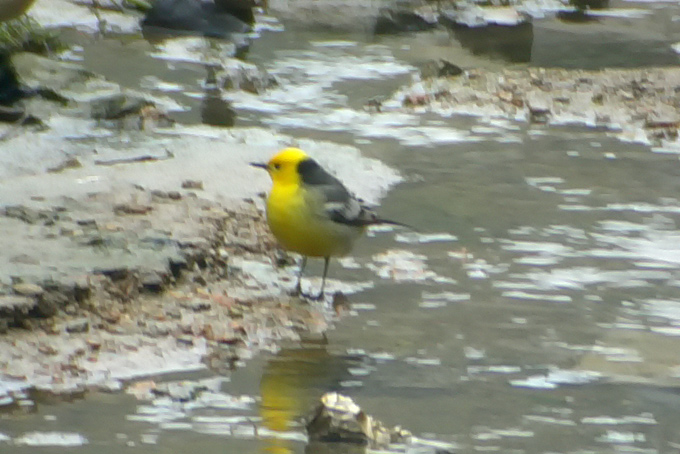
Eocheong Island, April 21
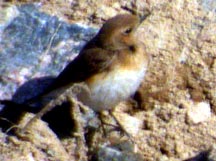
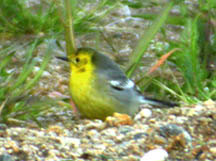
Photos © Nial Moores
With clear skies and a brisk force 3-4 NW wind, there was a major departure of most migrants, with only a small arrival in the mid-afternoon...however, still 80 species logged, including the usual Grey and Brown Thrushes, 3-4 Narcissus Flycatcher and a host of major national rarities.
In a remarkable sequence of sightings a long list of highlights included at least 1 Red-billed Starling (only recorded in Korea for the first time in April 2000), the Chinese Blackbird (first recorded in July 1999), a presumed "new" Greater Short-toed Lark, and one of the two "first record" Northern House Martins still; the reappearance of yesterday's Ferruginous Flycatcher (an extremely confiding individual, and only first recorded last year); a surpisingly elusive female Pied Wheatear (presumed the second record for South Korea, the first was in 1988); a male Pied Harrier and a Eurasian Tree Pipit, both found and photographed by Kawaguchi san (first recorded in May 2000, there are now about 10 records of Tree Pipit in Korea); and a Citrine Wagtail (about the tenth national record).

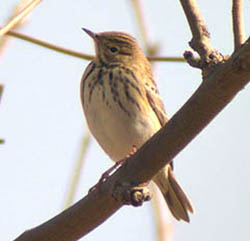

Eocheong Island, April 20
Continuing cold, with heavy overnight rain and thick fog through most of the day. Few new migrants appared to arrive (though single Chinese Pond Heron and Black-capped Kingfisher were both personal firsts for the year), and at least 10 Barn Swallow (out of ca 50 present) were found dead during the day. There was no sign of the possible Rosy Pipit of the 19th, but highlights included 1 Red-billed Starling and Greater Short-toed Lark still, and a "new" Chinese Blackbird. Another excellent record was of a Ferruginous Flycatcher found and photographed by KAWAGUCHI Sentaro in the late afternoon. Ferruginous Flycatcher was first recorded in Korea only last year, on Eocheong in April 2002 (see our note on the first records in our New Korean Species paper).
Almost incredibly there were 2 perched Northern House Martins today (see below, April 19) (with 1 Asian House Martin remaining 10 m away for prolonged near-direct comparison). We've posted a paper with more images at Northern House Martin.
Hong Island (north of Gageo Do), April 20
1 Grey Thrush, and 1 Brown Thrush.
Eocheong Island, April 19
Fog and heavy rain showers throughout the day led to a slowly increasing number and diversity of birds, with personal firsts for the spring including single Latham's Snipe, Swinhoe's Snipe, Richard's Pipit, Oriental Reed Warbler and Narcissus Flycatcher. A host of other good birds included the Japanese Waxwing still and 7 species of thrush - Brown (3+), Dusky (ca 75), Eye-browed (1), Grey (2+), Grey-backed (ca 15), Pale (ca 50) and White's (2) - as well as 2 Oriental Pratincole, a Greater Short-toed Lark, 1 Red-billed Starling, and a presumed Rosy Pipit (seen poorly in the evening with ca 12 Red-throated Pipit).
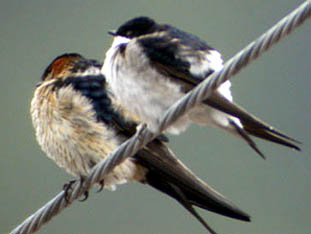
Photo © Nial Moores.
Outstanding highlight, however, was a Northern House Martin Delichon urbica lagopoda, perched on overhead wires with up to 60 Red-rumped (or "Lesser Striated") Swallow, within 10 meters of a similarly perched Asian House Martin. Identification was based largely on: the more extensive, uNial Mooresarked white rump, with white extending onto the uppertail coverts; the white chin (with white feathering extending up under the bill); the pure, uNial Mooresarked white vent; the bluer upperparts; and the perhaps very slightly more forked tail. As Northern House Martin has not been officially recorded in South Korea (though there is at least one unpublished record of one seen, but not photographed, in autumn in the northwest in the mid-1990s) we would very much welcome comments from those with experience of the relevant subspecies.
(Update 20 Apr: We've posted a paper with more images at Northern House Martin.)
Gangwha, April 19
Migration still seems to be slow in the Northwest, particularly in terms of passerines, and there are very few warblers here, and no flycatchers yet. In breezy, foggy, and misty conditions on Ganghwa Island today, highlights included 5 Black-faced Spoonbills, a Whiskered Tern(TA), 3 Hoopoes and a Fan-tailed Warbler at Seondu-ri, while above Jeondeungsa Temple along the fortress wall, there were two male Chinese Nuthatches.
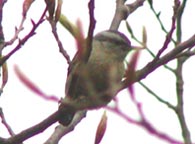
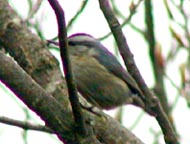
Eocheong Island, April 18
Beaufort Force 7 southerlies with thunder, fog (visibility down to less than 100 m at times) and heavy rain limited bird counting today...best were three personal firsts for the spring: Sand Martin, Siberian Rubythroat and Eye-browed Thrush, all more typical of early May than mid-April. In addition, the same or another Chinese Blackbird and the Japanese Waxwing were(still) present in the village, while there were 2 or more Grey Thrush on the road to the lighthouse, and at least 1 Asian House Martin there.
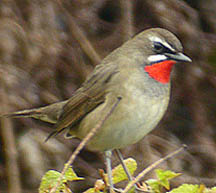

Hong Island (north of Gageo Do), April 17

Photo © Kim Dong Won
1 Ferruginous Flycatcher - the second Korean record, following one on Eocheong Island on April 30th 2002. (See also April 20th 2003 for details and images of a third record - this time from Eocheong Island again.)
We're grateful to Kim Dong Won for permission to reproduce the image below.
Eocheong Island, April 17
Strengthening southwest winds and good visibility stimulated many migrants to depart, so numbers of Dusky Thrush and chats were well down. However, still ca 80 Pale, 12+ White's, 25 Grey-backed, 3 Grey and 1 Brown Thrush were logged along with 1-2 Chinese Blackbird: a species first recorded in Korea in 1999. One thrush flock even contained ca 50 individuals - comprised of all 7 species!
Other good birds included 1 Japanese Waxwing, 2 Japanese Yellow and the first Chestnut Buntings (2), and a new high count of 3 Red-billed Starling.
Eocheong Island, April 16
Seasonally unusually hot (up to 28 C on the mainland) and clear weather meant, apart from large numbers of thrushes (including ca 200 Dusky, 100 Pale and 10+ Grey-backeds), comparatively few migrants present in the morning. However, Pintail Snipe, Oriental Cuckoo(3) and Yellow-browed Bunting(2) were all personal spring firsts. Again a good arrival then took place in the afternoon, containing the spring's personal first records of Rufous-tailed Robin, Japanese Yellow Bunting (2 in amongst mixed bunting flocks) and Yellow-rumped Flycatcher (3), as well as a handful of Siberian Blue Robin and Siberian Stonechat etc.
In addition, other good birds for the day included 2 Brown Thrush and the Red-billed Starling still, along with a male Red-flanked Bluetail showing a largely blueish supercilium suggesting the rufilatus subspecies along with many nominate cyanurus: we would welcome comments on theindividuals posted below.

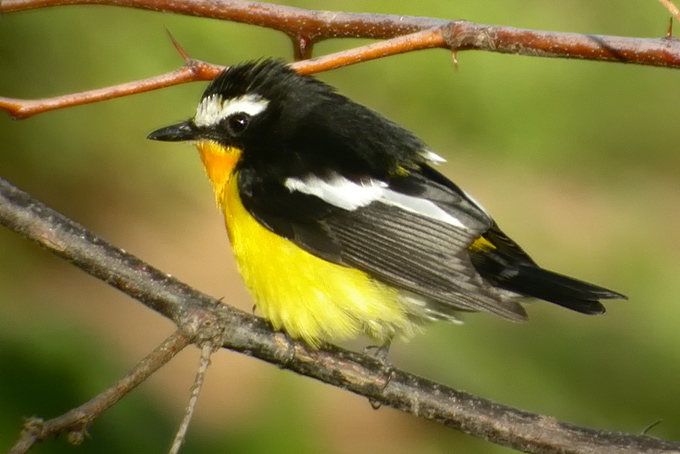

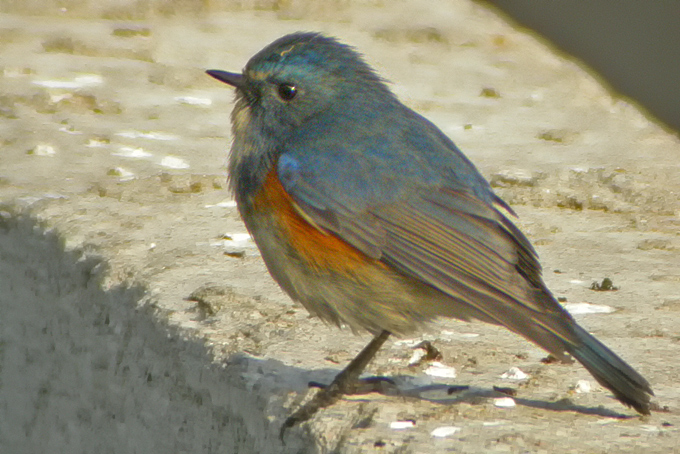
Eocheong Island, April 15
Despite the clear skies and light winds (from the north-west) a very large arrival took place during the afternoon, with at least 7 Siberian Blue Robin (personal first of the spring), 80 Asian Stubtail, 65 Siberian Stonechat (though less than 10 in the morning), and over 200 thrushes (largely Dusky and Pale with probably 10 each of Grey-backed and White's Thrushes) showing in the evening.
Other new arrivals included personal first-of-the-spring Blue-and-white Flycatcher, 2 Brown Flycatcher, 2 Oriental Scops Owl, 1 Yellow-browed or Inornateand ca 5 Pale-legged/Sakhalin Leaf Warbler, while high counts for 2003 also included ca 90-100 Red-flanked Bluetail, 20 Eastern Crowned, 10+ Korean Bush Warbler, and ca 40 Black-faced Bunting.
Other good birds included a female-type Red-billed Starling (see also the report below for April 01), in addition to ca 5 Pallas's and one suspected (but best left unclaimed!) Chinese Leaf Warbler.
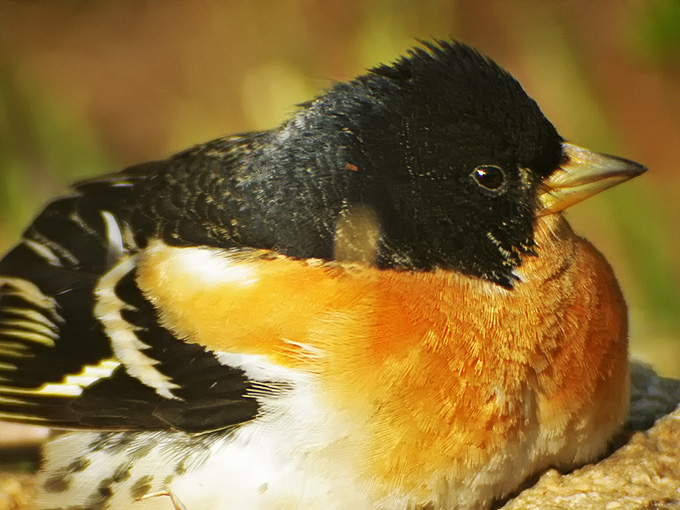
Eocheong Island, April 14 pm
Only 10 Streaked Shearwater and 4 Ancient Murrelet from the ferry to Eocheong, and on the island, in clear and calm conditions, 65 Siberian Stonechat and ca 90 Red-flanked Bluetail. Apart from 2-3 Dusky Warbler, best for the day was an overflying Black Woodpigeon (a first for Eocheong).
Nakdong estuary, April 14
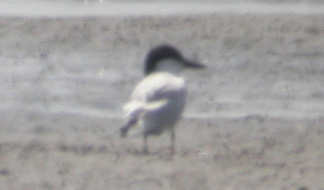
A (presumed adult) Gull-billed Tern Gelochelidon nilotica photographed on the Nakdong estuary, Busan, on April 13th is considered to be approximately the third record of this species.
Han-Imjin, April 15

Details and photograph received today from Dr LEE Ki-Sup of Korea's first Bar-headed Goose, found on the Han-Imjin on March 15th. For details, please go to our Rarity Reports page.
Hong Island (north of Gageo Do), April 13 - 14

1 Citrine Wagtail (an early date for this "vagrant"), 2 Grey Bunting.
We're grateful to Kim Dong Won for permission to reproduce the excellent image.
Seosan and Taean Peninsula, April 13
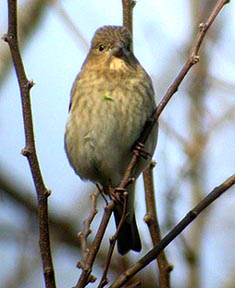
Brightening skies with a "fair number" of birds helped us log no less 102 species for the day. Very best were 5 Baikal Teal (with a couple of males displaying) and a Swan Goose still at Seosan, along with excellent views of singing Crested Lark (thanks to local birder Kim Hyun-tae, who kindly told us of a colony containing several individuals), and on the west coast an immature Upland Buzzard, and a Common Rosefinch.
Yeongjong and the Han-Imjin, April 12 pm
Overcast and foggy conditions, with a cold moderate wind, kept most migrants hidden, but shorebirds included ca 700 Great Knot (one carrying an orange leg flag), 800 Bar-tailed Godwit (2 with orange leg flags), 5 500 Dunlin, 1 800 Far Eastern Curlew and a Pied Avocet at Yeongjong. Also there ca 60-70 summer-plumaged Saunders's Gull.
On the Han-Imjin, still 90 Swan Goose and 6 White-naped Crane, along with 2 distant Ruddy Shelduck and ca 200 Mongolian Gull.Taejongdae, Busan, April 7
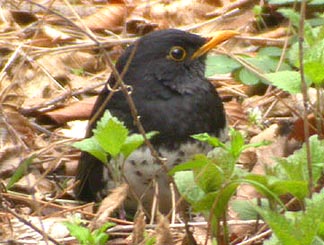
Another good day, with several personal firsts for the year including single Eastern Crowned Warbler and Asian Stubtail, ca 7 Grey-faced Buzzard Eagle, and 2 male Grey Thrush (listed as a vagrant in Lee, Koo and Park this species is perhaps better considered a local migrant along the west and south coasts).
Other birds of note included 2 Red-flanked Bluetail, 3 White's Thrush, ca 5 Pale Thrush, 50+ Siskin, 2 Siberian Stonechat, 2 male personata Black-faced Bunting, 2 or more (very skulking!)Grey Bunting still and a large, dark raptor silhouetted in overhead flight, considered to be either an adult Greater Spotted or a Steppe Eagle.
Gyeongju-Guryongpo, April 6
Warm spring sunshine and plenty of birds, with for example widespread japonicus Buff-bellied Pipit, 100+ Barn Swallow, 5 Asian House Martin and 7 Pacific Swift on the Guryongpo Peninsula, and various other highlights including ca 130 Japanese Waxwing in Pohang (accompanied by 10+ Bohemian), along with a presumed "Japanese" Meadow Bunting and 3 Long-tailed Rosefinch in gulleys near Daebo.
More expected species of interest included Long-billed Plover, Japanese Wagtail, and ca 5 Mandarin Duck at Gyeongju, and 7-15 Temminck's Cormorant, 15+ Pacific Diver (with 2 Black-throatedoffering excellent opportunities for direct comparison) and ca 25 Ancient Murrelet on the sea off Daebo.
Youngdong, April 7
32 Hooded Cranes passed through in the evening.
Upo wetland, April 6
5 White Spoonbills, 2 Garganeys, and 15 Spotted Redshanks
Joonam Reservoir, April 5
6 Ruffs, 6 Spotted Redshanks, 300+ Coots, and 150+ Tufted Ducks
Joonam, April 2

Martin was in South Korea for a short trip in early April. Highlights included this Long-billed Dowitcher on the 2nd - about Korea's 5th record. Still in non-breeding plumage, the bird was feeding on the left side of a marshy 'peninsula' in front of the watch tower on the retaining wall. An area of bunded lake held a Black-winged Stilt, 4 Ruff and some Spotted Redshanks.
Nakdong Estuary/Dadapo, April 2
500+ Common Shelduck, 10 Far Eastern Curlew and ca 40 japonicus Buff-bellied Pipit were the only birds of interest along the estuary's eastern flank.
In Dadapo, ca 8 Grey Bunting, 10+ Pale Thrush, 3 Olive-backed Pipit and 30 Siskin might have been either largely left over from the winter, or better, signs of migration underway.
Taejongdae, Busan, April 1
Little evidence of migration underway in strengthening northeasterlies, with only single Barn Swallow and leucopsis White Wagtail. However, ca 20 Yellow-throated Bunting present (with many in song), along with 3 Pale Thrush and 2 very late Grey Bunting (1 first year male and 1 female). Best bird, however, was (yet) another male Red-billed Starling. First recorded in South Korea in 2000 (see our New Species Paper), the species is proving to be increasingly regular, with this at least the third so far this spring....
Birds Korea 1108 Ho, 3 Dong, Samick Tower Apt., 148-22, Namcheon-Dong, Su-Young-Gu
Busan, 618-762 Republic of Korea





